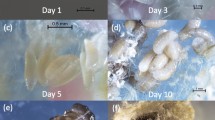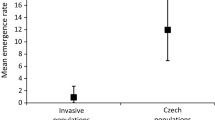Abstract
The European paper wasp Polistes dominulus (Christ) is a model system in the fields of behavioral ecology, ecological immunology, and invasion biology. Since its introduction to the US in 1978, its invasion success has been attributed, in part, to a lack of parasites or parasitoids infecting this population. This is despite the number of parasites which infest the native population and the generalist polistine parasites and parasitoids documented in sympatric North American species. Multiple studies have cited low parasite pressure as evidence that the invasive population of P. dominulus is benefiting from a post-invasion release from enemies. Here, we present the first well documented case of parasitoidism of the invasive population of P. dominulus in North America.


Similar content being viewed by others
References
Cervo R., Zacchi F. and Turillazzi S. 2000. Polistes dominulus (Hymenoptera, Vespidae) invading North America: some hypotheses for its rapid spread. Insect. Soc. 47: 155-157
Gamboa G.J., Noble M.A., Thom M.C., Togal J.L., Srinivasan R. and Murphy B.D. 2004. The comparative biology of two sympatric paper wasps in Michigan, the native Polistes fuscatus and the invasive Polistes dominulus (Hymenoptera, Vespidae). Insect. Soc. 51: 153-157
Gillaspy J.E. 1973. Behavioral observations on paper-nest wasps (Genus Polistes; Family Vespidae; Order Hymenoptera). Am. Midl. Nat. 90: 1-12
Giovanetti M., Cervo R. and Turillazzi S. 1996. Comb reutilization in Polistes dominulus (Hymenoptera: Vespidae). In: Insect Social Life (Le Moli F., Mori A. and Grasso D., Eds) 1: 101-105
Gould W.P. and Jeanne R.L. 1984. Polistes wasps (Hymenoptera: Vespidae) as control agents for lepidopterous cabbage pests. Environ. Entomol. 13: 150-156
Hathaway M.A. 1981. Polistes gallicus in Massachusetts (Hymenoptera: Vespidae). Psyche 88: 169-174
Hughes D.P., Beani L., Turillazzi S. and Kathirithamby J. 2003. Prevalence of the parasite Strepsiptera in Polistes as detected by dissection of immature. Insect. Soc. 50: 62-68
Liebert A.E., Gamboa G.J., Stamp N.E., Curtis T.R., Monnet K.M., Turillazzi S. and Starks P.T. 2006. Genetics, behavior and ecology of a paper wasp invasion: Polistes dominulus in North America. Ann. Zool. Fenn. 43: 595-624
Makino S. 1985. List of parasitoids of polistine wasps. Sphecos 10: 19-25
Nannoni A., Cervo R. and Turillazzi S. 2001. Foraging activity in European Polistes wasps (Hymenoptera Vespidae). Boll. Soc. Entomol. Ital. 133: 67-78
Nelson J.M. 1968. Parasites and symbionts of nests of Polistes wasps. Ann. Entomol. Soc. Am. 61: 1528-1539
Queller D.C. and Strassmann J.E. 1988. Reproductive success and group nesting in the paper wasp, Polistes annularis. In: Reproductive Success: Studies of Individual Variation in Contrasting Breeding Systems (Clutton-Brock T.H., Ed), University of Chicago Press, Chicago USA. 76-96 pp
Rau P. 1941. Observations on certain Lepidopterous and Hymenopterous parasites of Polistes Wasps. Ann. Entomol. Soc. Am. 34: 355-585
Riley C.V. 1893. Annual address of the President: Parasitism in Insects. Proc. Entomol. Soc. Wash. 2: 397-431
Rusina L. Yu. 2008. Reaction of parasitoids of the paper wasp Polistes dominulus (Christ) (Hymenoptera, Vespidae, Polistinae) to the host distribution. Entomol. Rev. 88: 881-897
Sambaraju K.R. and Phillips T.W. 2008. Responses of adult Plodia interpunctella (Hubner) (Lepidoptera: Pyralidae) to light and combinations of attractants and light. J. Insect Behav. 21: 422-439
Schmid-Hempel P. 1998. Parasites in Social Insects. Princeton University Press, Princeton New Jersey. 319 pp
Scudder G.E. and Cannings R.A. 2007. The Lepidoptera Families and Associated Orders of British Columbia. (FIA FSP Project No. Y073001). British Columbia: Ministry of Forests and Range Publication. Retrieved from http://www.for.gov.bc.ca/hfd/library/FIA/2007/FSP_Y073001c.pdf
Starks P.T. and Turillazzi S. 2006 (Eds). Polistes paper wasps: emergence of a model genus. Ann. Zool. Fenn. 43: 385-386
Starr C.K. 1976. Nest reutilization by Polistes metricus (Hymenoptera: Vespidae) and possible limitation of multiple foundress associations by parasitoids. J. Kans. Entomol. Soc. 49: 142-144
Strassmann J.E. 1981. Parasitoids, predators, and group size in the paper wasp, Polistes exclamans. Ecology 62: 1225-1233
Whiteman, N.K. and Landwer B.H.P. 2000. Parasitoids reared from Polistes (Hymenoptera: Vespidae: Polistinae) nests in Missouri, with a state record of Elasmus polistis Burks (Hymenoptera: Elasmidae). J. Kans. Entomol. Soc. 73: 186-188
Wilson-Rich N. and Starks P.T. 2010. The Polistes war: weak immune function in the invasive P. dominulus relative to the native P. fuscatus. Insect. Soc. 57: 47-52
Yamane S. 1996. Ecological factors influencing the colony cycle of Polistes wasps. In: Natural History and Evolution of Paper-Wasps (Turillazzi S. and M.J. West-Eberhard, Eds), Oxford University Press, New York USA. 75-97 pp
Young M. 1997. The Natural History of Moths. T&A D Poyser Ltd., London. 69 pp
Acknowledgments
This research was supported by a Tufts Institute of the Environment Fellowship from Tufts University to A.A.M. and a USA National Science Foundation-REU site award to Tufts University (DBI-0649190). The authors would like to thank Codman Farms for allowing for the collection of their nests; J. Soriano for his assistance with observations; M.A. Metz (USDA) for his assistance in identifying C. iphitalis; and two anonymous reviewers for valuable comments on an earlier version of this manuscript. The recent data capture efforts of J.A. Lewis facilitated in the relocation of specimens in alcohol.
Author information
Authors and Affiliations
Corresponding author
Rights and permissions
About this article
Cite this article
Madden, A.A., Davis, M.M. & Starks, P.T. First detailed report of brood parasitoidism in the invasive population of the paper wasp Polistes dominulus (Hymenoptera, Vespidae) in North America. Insect. Soc. 57, 257–260 (2010). https://doi.org/10.1007/s00040-010-0079-0
Received:
Revised:
Accepted:
Published:
Issue Date:
DOI: https://doi.org/10.1007/s00040-010-0079-0




